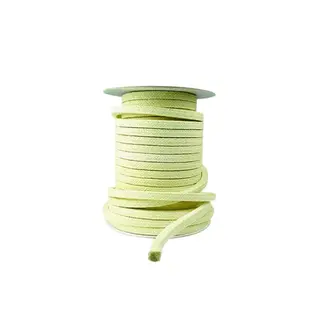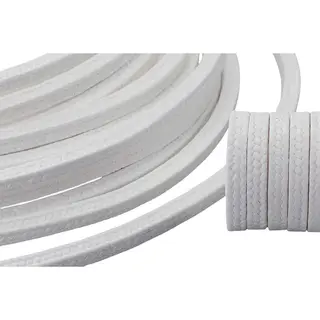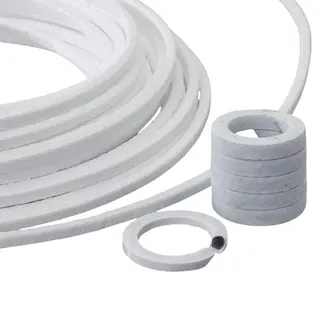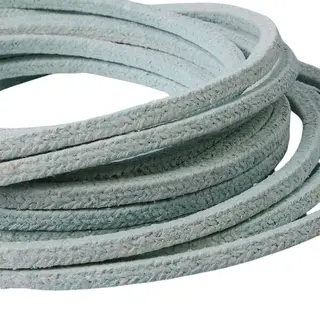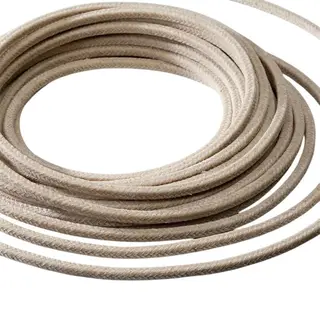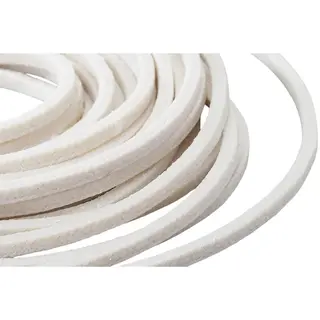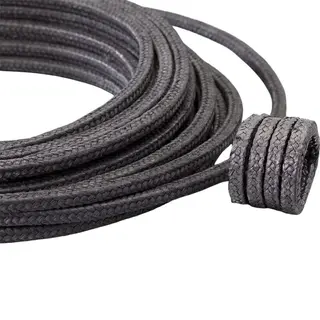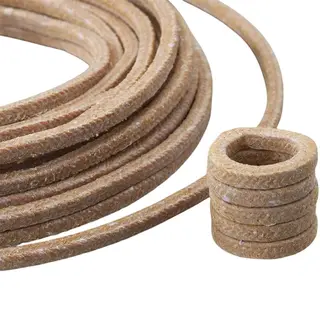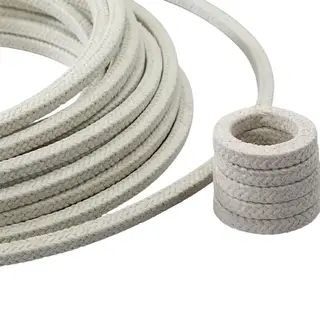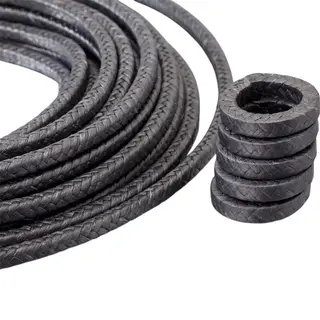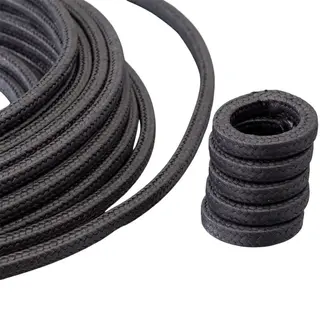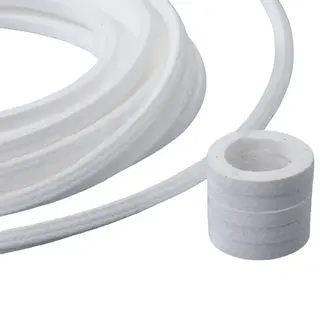Material: Composed of PTFE yarn that contains graphite particles.
Characteristics: Provides outstanding self-lubrication and thermal conductivity, making it suitable for high-speed and high-temperature applications.
Material: Constructed from multiple PTFE yarns that are sintered and fully stretched, then impregnated with PTFE.
Characteristics: Features good flexibility, high dimensional stability, resistance to compression and extrusion, and high structural strength and density. It is ideal for a wide range of industrial applications, especially those involving high pressure, high speed, and high temperature.
Material: Made from pure PTFE yarn and treated with a special lubricant, such as silicone oil.
Characteristics: Has a low friction coefficient, which prevents heating even at high peripheral speeds. It is well-suited for highly corrosive and oxidative chemical products, particularly in industries where contamination is not acceptable, such as food, pharmaceuticals, and paper production.
In the quest for environmental sustainability and regulatory compliance, industries are increasingly adopting stringent standards to minimize fugitive emissions. These standards not only help in reducing harmful pollutants but also enhance safety and operational efficiency. Here are some key standards that play a crucial role in achieving low emission goals:
ISO 15848 standardizes the measurement, testing, and evaluation procedures for industrial valve fugitive emissions. This standard is divided into two parts. ISO 15848-1 defines the test procedures for valve type testing, and ISO 15848-2 specifies the requirements for the manufacturing of valve products.
The German fugitive emission control law TA-LUFT VDI2440 defines the leakage rate, testing, and testing methods.
According to TA-LUFT and VDI 2440, the flange connection must meet the test pressure of 1 bar under the condition that the leakage rate is less than 10−4 mbar × l/(s × m). VDI 2200 specifies the selection, calculation, design, installation, and testing process of the flange connection. It also allows reference to VDI 2440 for the leakage rate. VDI 2200 also stipulates the burst pressure test to avoid the risk of flange breakage and sudden leakage.
The Clean Air Act stipulates that the maximum allowable leakage rate for valves, pumps, and agitators in the United States must comply with the EPA Method21 (blower method) for leakage testing, and the testing method must be consistent.
API 622 is the second edition of the international performance test for disk root materials, which includes temperature, pressure, thermal cycles, and mechanical cycles. API 622 specifies 1510 mechanical cycles and 5 thermal cycles, from room temperature to 260°C (500°F), pressure from 0 to 600 psi (0-41bar), for high-temperature testing. Under carbon equivalent testing, the allowable leakage rate is 100 ppm.
The first edition of the API 624 standard for the type test of the fugitive emission of the valve with a graphite seal includes the up and down motion and rotation of the valve, with a maximum diameter of 24 inches. The test requires the temperature to rise to 260°C (500°F) and perform 310 mechanical cycles and 3 thermal cycles, with the maximum allowable leakage rate being 100 ppm. The valve to be tested must first be tested according to API 622, and the temperature range is from -29°C to 538°C (-20°F to 1000°F).
PTFE packing boasts a range of notable benefits that have made it a favored option in numerous industrial settings. These advantages are rooted in the intrinsic characteristics of PTFE as a material, such as its chemical inertness, thermal stability, low friction, and adaptability. Let's delve into these key benefits in more detail.
A standout feature of PTFE packing is its extraordinary chemical inertness. PTFE is highly unreactive, meaning it remains stable in the presence of most chemicals, acids, and solvents. This property renders PTFE packing highly suitable for use in environments with harsh chemicals, where other materials would corrode or deteriorate. Whether utilized in pumps, valves, or other machinery, PTFE packing can endure extended exposure to aggressive chemicals without compromising its structural integrity or sealing capabilities. This ensures the reliability of the seal, reduces maintenance frequency, and ultimately lowers operational costs while enhancing equipment reliability.
PTFE packing is renowned for its impressive temperature resilience, performing effectively across a broad temperature spectrum. It can withstand extreme cold and heat, maintaining its structural integrity from cryogenic temperatures up to over 250°C (482°F). This temperature stability makes PTFE packing ideal for applications where other materials might fail due to thermal expansion, contraction, or degradation. Industries such as aerospace, chemical processing, and power generation, which often operate in extreme or fluctuating temperature conditions, benefit significantly from the consistent performance of PTFE packing.
Another crucial advantage of PTFE packing is its remarkably low friction coefficient. PTFE's non-stick nature minimizes friction between the packing and the moving components of equipment, such as valve stems, shafts, and pistons. This reduced friction not only extends the service life of both the packing and the equipment but also lowers maintenance requirements. Additionally, lower friction translates to less energy consumption, enhancing operational efficiency and reducing energy costs. This characteristic is particularly advantageous in dynamic applications where continuous movement could otherwise cause rapid wear and tear.
PTFE packing is widely used in various industries due to its chemical resistance, temperature stability, low friction, and versatility. Here are its common applications:
PTFE packing is a primary choice for sealing pumps, valves, and other mechanical equipment to prevent leaks of fluids and gases. It is particularly effective in harsh environments like petrochemicals and refineries, where it withstands high pressures and temperatures.
In chemical processing, PTFE packing is essential for its resistance to aggressive chemicals. It is used in reactors, mixers, and storage tanks to maintain seal integrity and prevent hazardous leaks. PTFE graphite packing is favored for its enhanced thermal conductivity, ensuring safe and efficient operations.
PTFE packing is ideal for food processing due to its non-reactive, non-toxic, and non-contaminating properties. It is easy to clean, resists bacterial growth, and meets food safety regulations, ensuring that food products remain safe and pure.
In pharmaceuticals, PTFE packing is crucial for maintaining sterile conditions and preventing contamination. Its inert properties and resistance to cleaning agents and solvents make it a reliable choice for reactors, mixers, and valves, ensuring product purity and safety.
